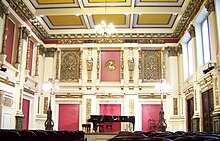Prayner Conservatory

The Prayner Conservatory of Mag. Josef Schmid is a music school in Vienna . Bankruptcy was filed on June 26, 2020 . The Conservatory's public rights had previously been withdrawn, and an appeal was filed against it. The conservatory is currently officially closed.
history
The conservatory was founded in 1905 by the music teacher Eugenie Patonay as a music school and then continued as a conservatory for music and dramatic arts. In 1911 the institute moved to the premises of the former Ehrbar piano manufacturing company . Soon acting and ballet classes were also offered.
Kurt Steinitz was the owner of the property in Mühlgasse until 1938. After Austria was annexed to the German Reich in March 1938, Steinitz fled to South America and the property was managed as trustee by the Gestapo lawyer, Stefan Lehner . In 1939 the Conservatory for Music and Dramatic Art was Aryanized by the couple Karl and Margarethe Prayner . The transfer was recognized in court after 1945, and provisions and financial compensation followed.
The Prayner Conservatory was one of the first conservatories to receive public rights from the Federal Ministry of Education, Science and Research with a decree of March 31, 1958 , which was later revoked.
The Conservatory is headquartered in the listed Palais Ehrbar in Vienna's 4th district of Wieden . In addition to the listed Ehrbarsaal, there are 21 classrooms, a small concert hall, a ballet hall , a rehearsal stage and two theory halls . Since 2011 there has been another location in Mariahilfer Straße . There is a commissioned theater, four rehearsal stages, a ballet hall, two theory halls and around 20 classrooms and practice rooms for studying music.
Study and training
Studies at the Prayner Conservatory are divided into sections and semesters, depending on the field of study, similar to those at universities in accordance with the 2002 University Act . For admission to the course, an entrance examination is required, which consists of at least three to four pieces. Around a quarter of the candidates are accepted. In the 2019/20 school year, around 800 students from over 50 countries were taught in all artistic departments.
The training takes place in the areas of classical music and jazz .
-
Classic :
- Piano , piano chamber music , accompaniment , solo voice , song and oratorio , violin , viola , cello , double bass , flute , clarinet , oboe , bassoon , horn , trombone , trumpet , tuba , guitar , harp , accordion , percussion
- Orchestral repertoire
- Sound setting / songwriting / composition
- Conduct
- Opera , operetta , operatic repertoire
-
Jazz :
- Jazz piano , jazz singing , jazz guitar , jazz saxophone , jazz drums , jazz electric bass , jazz bass / jazz double bass , jazz violin , jazz wind instruments
In addition to studying with the aim of obtaining an artistic degree, the conservatory offers "adult education" as an additional option.
In the premises of the Prayner Conservatory there are around 30 grand pianos , 30 pianinos and other instruments necessary for teaching. One of the few microtonal organs still in use and well cared for in Europe is also in the Prayner Conservatory. For this enharmonically -mikrotonale organ by Hans-André Stamm Prayner Conservatory in Vienna has Ulf-Diether Soyka numerous works written. Soyka teaches composition and composition and also leads a seminar for microtonal composition at the Prayner Conservatory in Vienna .
The European Credit Transfer and Accumulation System (ECTS), which has been introduced for the conservatory in addition to proof of academic success, is intended to ensure that the achievements are recognized across borders. The conservatory has been an active member of the AEC since 2008 .
Lecturers
The teaching staff consists of more than a hundred teachers, including Tamara Atschba, Daniel Auner , Louise Chisson, Maksimiljan Cencic, Stephen Chaundy, Filimon Ginalis, Barbara Górzyńska, Ralf Heiber, Roland Horvath, Alexandra Karastoyanova-Hermentin , Anna Kandinsky, Galina Mauracher , Volker Kempf , Margarita Kyriaki-Wagner, Giorgi Latso , Robert Lehrbaumer, Victoria Loukianetz , Matthias Maurer, Stephan Möller, Walter Moore, Valbona Naku, Karin Reda, Gerald Smrzek, Jörg Schneider, Teodora Sorokow, Massimo Stefanizzi, Ulrike Steinsky , Josef Stolz and Franz Zettl .
Individual evidence
- ↑ Bankruptcy of a well-known music conservatory with 170 employees. In: kurier.at. June 26, 2020, accessed July 23, 2020 .
- ^ Insolvency file, Commercial Court Vienna, file number 3 S 58 / 20d. July 6, 2020, accessed August 22, 2020 .
- ↑ Kaiser, Musikschule Österreichisches Musiklexikon online, accessed on August 24, 2018
- ^ History. In: schauspiel.prayner.at. March 31, 1958, accessed January 4, 2019 .
- ↑ public law rechteasy.at, accessed on August 24, 2018
- ↑ Finding aid entry for teaching establishments
- ↑ Music lexicon day Ehrbar family
- ↑ Musikerziehung.me musikerziehung.me, accessed on August 24, 2018
- ↑ Konservatorium-prayner.at , accessed on August 24, 2018
- ↑ Microtonal Music Austrian Music Lexicon online, accessed on August 24, 2018
- ↑ Consolidated federal law: Entire legal regulation for student grants for students at conservatories Federal legal information system, accessed on August 24, 2018
- ^ Prayner Conservatory Facebook, accessed August 24, 2018
- ↑ Alexandra Karastoynova-Hermentin Austrian Music Lexicon online, accessed on August 24, 2018
- ↑ Josef Stolz Austrian Music Lexicon online, accessed on August 24, 2018
Web links
Coordinates: 48 ° 11 '46 " N , 16 ° 21' 44" E

